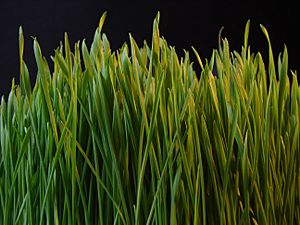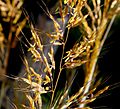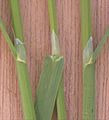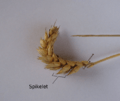Grass facts for kids
Grass is a common type of plant that often covers the ground, like in a lawn. When you think of grass, you might picture the green stuff in your yard or on a sports field.
Grasses are part of a bigger group of plants called graminoids. These plants usually have narrow leaves that grow from their base. This group includes the "true grasses" (from the Poaceae family), as well as plants like sedges and rushes. Even though they look similar, these three families are not closely related.
True grasses are very important! They include cereals like wheat and rice, tall bamboo plants, and the grass you see in lawns and grasslands.
People use graminoids for many things. They are a source of food (like grains), drinks (like beer and whisky), and pasture for livestock (farm animals). Grasses are also used for thatching roofs, making paper, fuel, clothing, insulation, and even for building things. You can also find them on sports fields and in basket weaving.
While many grasses are short, some, like bamboo, can grow incredibly tall. Grasses are tough plants and can grow in many different places, even in very cold or very dry areas. Some other plants that look like grass, such as rushes, reeds, and papyrus, are not actually part of the grass family.
Grasses are a vital food source for many animals. Think of deer, buffalo, cattle, mice, grasshoppers, and caterpillars. Unlike other plants, grasses grow from the bottom up. This means when animals eat the top part, they usually don't destroy the part that helps the grass keep growing. Grass also helps hold the soil in place, preventing erosion (when dirt washes away into rivers).
Contents
How Grass Evolved
Grasses are incredibly adaptable plants. They started to become widespread towards the end of the Cretaceous period, which was a long time ago! Scientists have even found fossilized dinosaur poop that contained tiny bits of grass, showing that dinosaurs ate grass.
Grasses have learned to live in many different environments, from lush rain forests to dry deserts, cold mountains, and even along the coast where the ocean tides come in. Today, they are the most common type of plant on Earth. Grass is a very important source of food and energy for many animals around the world.
Grass and People
People have used grasses for thousands of years. You often see lawn grass planted around buildings and on sports fields. Sometimes, special chemicals and water are used to help these lawns grow green and strong.
We eat many parts of grasses. Corn, wheat, barley, oats, rice, and millet are all cereals. These are common grains whose seeds are used for food and to make drinks like alcohol (for example, beer).
Did you know that sugar cane, which is where we get sugar, is also a plant in the grass family? People started growing grasses to feed farm animals about 10,000 years ago. Grasses have also been used to make paper for more than 4,000 years.
People use bamboo, a type of grass, to build houses, fences, furniture, and many other things. Grass plants can also be used as fuel to burn for energy, to cover roofs (called thatching), and to weave baskets. It's interesting to know that some people believe grass shouldn't be cut too short, as it can damage the plant and cause brown spots.
Grass in Everyday Language
The word "grass" appears in several common phrases in English. Here are a few examples:
- "The grass is always greener on the other side" means that people often think what others have is better than what they have.
- "Don't let the grass grow under your feet" means you should do something and not waste time.
- "A snake in the grass" describes a person who seems friendly but is actually dishonest and might try to trick others.
Related pages
- True grasses, a large family of monocot flowering plants.
Images for kids
-
A kangaroo eating grass
-
Wind-blown grass in the Valles Caldera in New Mexico, United States
-
The gray area is the cricket pitch currently in use. Parallel to it are other pitches in various states of preparation which could be used in other matches.
-
Grass-covered house in Iceland
-
A Chasmanthium latifolium spikelet
-
Barley mature spikes (Hordeum vulgare)
-
Illustration depicting both staminate and pistillate flowers of maize (Zea mays)
See also
 In Spanish: Gramíneas para niños
In Spanish: Gramíneas para niños



























